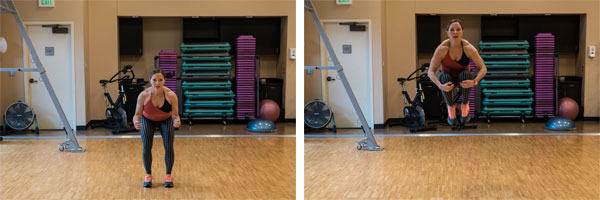

Without moving your hands, jump your feet forward, driving your knees toward your chest. Start in a plank position with your palms and the balls of your feet pressed against the ground. Perform a burpee as usual, but instead of doing a small hop and overhead clap, finish the movement with a tuck jump. “Jump up from a lunge position, bringing your knees to your chest before landing with your opposite leg forward.”

“My favorite variation on the tuck jump is the jump lunge with tuck,” says Thieme. Mastered the tuck jump and ready to take things up a notch? Luckily, there are plenty of tuck jump exercise variations. Land softly with your feet hip-width apart and your knees slightly bent.As you jump, pull your knees up toward your chest.Bend your knees in a quarter squat and, exploding off the balls of your feet, jump straight up in the air.Stand with your feet hip-width apart and lift your fully extended arms, palms down, to chest height.“Don’t land with locked knees - land softly with your knees slightly bent to absorb the impact,” says Thieme. You want to tuck your knees as far toward your chest as possible.”Īnd, like with most plyo moves, to keep your knee, hip, and ankle joints safe, it’s crucial that you land softly. “A lot of people only bring them to hip level. “The key to performing the tuck jump properly is to really drive your knees up when you jump,” says Thieme.
MUSCLES WORKED IN TUCK JUMPS HOW TO
Plyometric Training The tuck jump is a plyometric exercise and therefore offers many of the benefits of plyometric trainingto coaches and athletes.Incorporating a dynamic movement like the tuck jump into a circuit-training workout may help you improve your jump shot, tennis game, or even your 5K time.Īnd because the tuck jump exercise targets the body’s type II muscle fibers, tuck jumps can also fine-tune your agility and build butt- and leg-defining muscles.īut before getting started, learning how to do a tuck jump properly is important for maximizing the tuck jump’s benefits and minimizing your chance of injury. Is the tuck jump a plyometric training exercise? That is, vertical jumps, along with Olympic weightlifting exercises such as the clean, have the hips, knees, and ankles all extending simultaneously to generate explosive movement. Interestingly, unlike other vertical jumps, the tuck jump is not purely a triple-extension movement. How are tuck jumps different from other vertical jumps? As with many jump exercises, this an explosive movement-and when you land on the ground, these four areas of the body absorb the impact.


If you have a knee, ankle, back or hip problem, you're going to want to skip the tuck jumps altogether. Plyometric Training Plyometrics have been shown to increase rate of muscle contraction, increase power outputs, enhance muscle performance in ballistic movements, and ultimately increase athletic performance (specifically power). What are the benefits of a tuck jump?īelow are five benefits of the tuck jump, many of which as inherent to lower body plyometrics. Maayan Patito attempted this record to set a personal goal. The most tuck jumps on a trampoline in one minute is 63, achieved by Maayan Patito (Israel), in Petach Tikva, Israel, on 11 March 2018. And if it's done over and over again, it can lead to painful tendonitis and ligament stress. This drastically increases the impact on your knees. When you jump off a box-especially a high one-your weight and gravity pull you toward the floor.


 0 kommentar(er)
0 kommentar(er)
